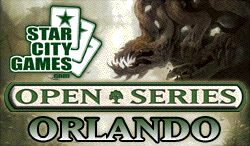The first batch of Rise of the Eldrazi spoilers are here, and we’ve got ‘em!
All in all, I have six cards to review, and I’ll give you my thoughts on each of them in general and then, of course, how they’ll play in the Greatest Format Known to Man.
From a flavor standpoint, I’m a big fan of The Rise of the Eldrazi backstory.
For thousands of years, Zendikar has had a reputation as a deathtrap, a world of deadly perils to Planeswalkers and native explorers alike, punishing any who seek to loot its hidden treasures and exploit its potent mana.
Unknown to the plane’s denizens, however, there’s a sinister reason for Zendikar’s danger: for millennia, the plane has served as a prison for the Eldrazi, astral monstrosities native to the Blind Eternities. Now, the perils facing adventurers on the plane of Zendikar have taken an even deadlier turn. The Eldrazi have been released.
Hailing from the Blind Eternities, the space between planes, the Eldrazi have transcended the colors of mana as we know them. As a result, the Eldrazi progenitors themselves and those closest to them are colorless. But don’t let the mana cost fool you – these Eldrazi are not artifacts.
Each of the colossal Eldrazi spawns its own “brood lineage.” The three brood lineages are composed of Eldrazi Drones and other subordinate beings, each reflecting the image of its progenitor. The smaller Eldrazi Drones that are aligned with colored mana and many of these drones, as well as some spells, produce Eldrazi Spawn creature tokens.
These 0/1 colorless creatures can be sacrificed to add one colorless mana to your mana pool – perfect for casting those enormous Eldrazi.
The Rise of the Eldrazi set also marks the debut of colorless instants and sorceries. Like their Eldrazi creators, these versatile spells can be put into almost any deck.
As Ken Nagle, lead developer of the set, recently Tweeted: “(Ken) wonders if Sheldon Menery will be happy that Eldrazi completely warp EDH, or if Sheldon Menery will be sad that Eldrazi completely warp EDH. I guess that remains to be seen.
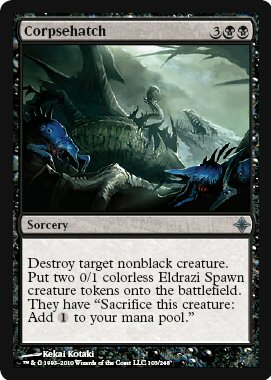
Clearly this is designed less as creature removal and more as a method of getting big, fat, crazy Eldrazi creatures into play. I certainly can’t imagine it played much in other Constructed formats, but in Limited, creature removal is creature removal, so you’ll see it played.
In EDH, other 3BB destroyers of a single creature don’t see much action. Annihilate is an Instant plus you draw a card, and I can’t remember ever seeing in played. Brainspoil has the “can’t regenerate” clause plus Transmute, and I’m sure I’ve never seen it in the 100-card decks. Gloomlance is a terrible version of Annihilate, since the opponent draws the card if the creature is Green or White. The creature can’t regenerate from Sever Soul and you gain its Toughness in life, and it never gets played. Weed Strangle, which is a worse version of Sever Soul, is a card no one has ever even heard of.
This means in order for Corpsehatch to get played in EDH, it will have to find a niche in a deck that does something with the tokens. The obvious is creating mana to fuel ramping up to things like Kozilek. A little outside the box, we can consider it in a BG deck that sports Gaea’s Cradle. You can first tap the Cradle for mana, then sacrifice the Spawn tokens, effectively doubling your production. Since you’re already playing Black, add Grave Pact or Butcher of Malakir to get extra value out of sacrificing those tokens.
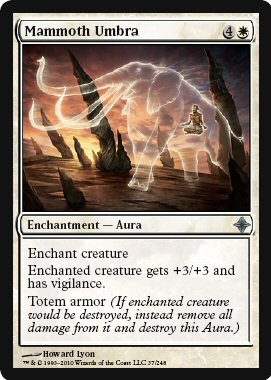
This is a very sexy card, and I see it getting played in Constructed and Limited, and for sure, EDH.
The only other 4W Aura is Soaring Hope, which might have a few janky uses, but Mammoth Umbra is clearly something very new. The only real comparison is to Elephant Guide, which saw a great deal of play in its day. Mammoth Umbra is loads better for EDH, since it lets you keep the creature you’ve enchanted with it instead of getting some little 3/3 dude. Vigilance certainly helps in the multiplayer format, and a little beef to your already-beefy guy is excellent.
The first creature I thought of to enchant with this is Uril, the Miststalker. Uril is already hard enough to kill since he has Trollshroud. Folks generally have to resort to board-sweepers or sacrifice effects to get rid of him, the latter being less useful if the Uril player has even a few extra dudes. Mammoth Umbra makes Uril 10/10 right away, and effectively immune to the first reset button. Note that if that reset button is a Disk or O-Stone, the creature is still going to survive, since the replacement effect saves the creature from the destruction event at the same time the Aura is being destroyed by that event.
Obviously, any creature will benefit from the bonus and protection of Mammoth Umbra. My thoughts are running to creatures with Lifelink, but maybe that’s because of the White mana. A random suggestion is Uril’s dorky cousin Rabid Wombat. Completely janky thinking might include Evershrike, especially if you can put enchantments back in your hand, like with Skull of Orm, Dowsing Shaman (who should see more EDH play than he does), and Auramancer.
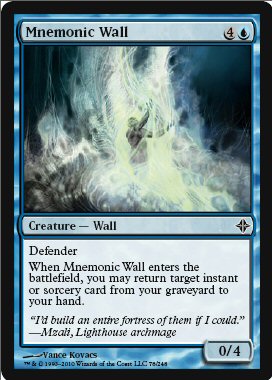
Okay, combo players, here you go. Recursion is key to combo and loop strategies, and this little guy does it without having to branch out in Green if you don’t want to. I can’t really see this getting played much in Standard or even Limited, but I could be wrong about the latter.
In EDH, it seems like it could be a key in something that wants to recur turn-taking cards like Time Warp, Time Walk, and Time Stretch. The fact that it doesn’t fly isn’t going to help with protecting your enchantments and artifacts from Trygon Predator, and it’s not going to stop much that you’d want to block (like Shadowmage Infiltrator), so I’m pretty sure its complete value is in getting back your turn-takers or other big, splashy Instants or Sorceries. To its credit, it’s a better version of Anarchist, since it’s Blue, and it can also get an Instant. Combine it with something like Galepowder Mage, and you might be onto a further recursion loop. In the end, I think it’s going to be a card that some folks make an effort to do something with, then go back to however they were trying to do it in the first place.
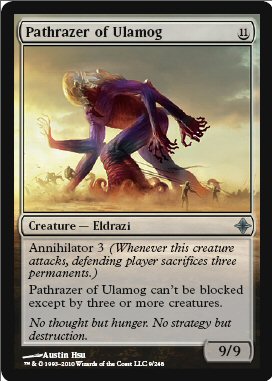
When you first saw Kozilek, you new Annihilator was going to be on more than one card. Well, here’s another one, and this one is pretty straightforward. It’s unlikely to get played in Limited formats without the ability to get to 11 mana pretty quickly. I can certainly see some Constructed deck making use of getting this guy in the yard and then reanimating him, or as we’re all suspecting, some way of quickly ramping up to 11.
My first thought when I saw the Annihilator mechanic was “Really? Sacrifice X permanents? Really?” I’m seriously hoping that Rise of the Eldrazi also comes with some cards that do bad things to someone that forces you to sacrifice stuff. That might bring back a little balance. Otherwise, the Annihilators are going to run rampant.
In more cutthroat EDH games, this guy will see play, will get Entombed or Buried Alive, and get reanimated early. The nine damage will be secondary to wiping out everyone’s early boards. Turn 13, this guy isn’t devastating, although probably still very good. Turn 3, he sure is.
The two decks that scream for Pathrazer of Ulamog are Thraximundar and Kresh, for obvious reasons. Sacrificing creatures means that Thraximundar will perhaps get a General kill a turn earlier, and Kresh will just get enormous.
I know that I’ll play this guy, but I’m also pretty sure other folks will also, so my immediate thoughts are going to what I’m going to do. Grave Pact and Butcher of Malakir certainly suggest themselves quickly, and they’re cards I’m already playing. Abyssal Gatekeeper might be a little too much. Remember, once the Annihilator ability triggers, you’re going to have to sacrifice stuff even if the Pathrazer goes away. Not getting attacked also seems like good defense. Blazing Archon, Peacekeeper, Moat, and the like will help. Perhaps it’s time to dust off Island Sanctuary. Exiling the Pathrazer is probably an excellent idea (Swords to Plowshares, Path to Exile, and the like), since the guys playing it are likely to be able to recur it.
Pathrazer is no Kozilek, but it’s still pretty awesome and will see plenty of EDH play.
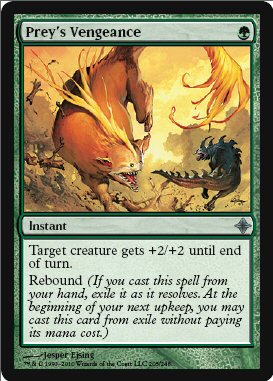
This one may see some play in Standard and in Limited. The initial casting is a combat trick, but what you pay for in not having to cast it again you lose in surprise factor.
More interesting to me than this card itself is the Rebound mechanic. I’ll be interested to see what else comes down the pike, and if there’s a geometric progression of mana costs. Prey’s Vengeance can afford to cost only G, since its effect isn’t completely game-altering. If there is a Rebound version of something like Vindicate, I’d be really likely to play it at five mana, and would probably still consider it at six.
The big thing to take out of the Rebound mechanic is that it doesn’t combo with Cascade. Cascade cards are cast from the Exile zone, not from your hand.
As we wait to see what other Rebound cards come out in the set, I’ll say that I highly doubt Prey’s Vengeance gets played in EDH.
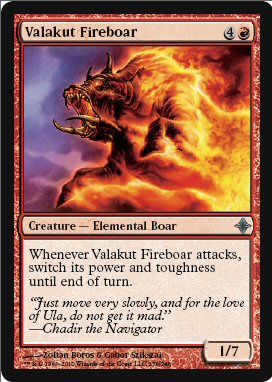
Meh. He’s Red, so maybe you’re playing him in a Standard deck with removal to clear the path for him, and he’s hard to kill with damage on your opponent’s turn, but at the same CMC, you have way better choices in Standard (Siege-Gang Commander, anyone?), and even at 4R, I’d probably play Grotag Thrasher or Kazuul Warlord first.
When I think of 1/7 creatures in EDH, my thoughts immediately go to Doran, but certainly you can’t play this guy in a Doran deck.
I hope you’ve enjoyed this walk through a first few of the new cards to be spoiled. I’m confident at this point that Rise of the Eldrazi will have a significant impact on the format. Specifically what impact is still a mystery.
Next week, join me as I recount the thrilling final week of the latest iteration of the Armada Games EDH League, where plenty Chaos will most certainly be Embraced!

